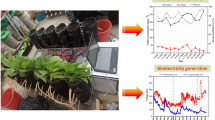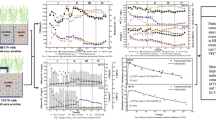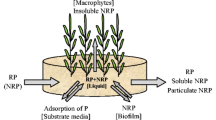Abstract
The nitrogen removal efficiency in constructed wetlands (CWs) was largely affected by the dissolved oxygen (DO). In this study, micro-aeration with different numbers of hollow fiber membrane modules (HFMEs) was adopted to increase the oxygen availability and improve the nitrogen removal efficiency in CWs under different air temperatures and different hydraulic retention time (HRT). Compared to the plant oxygen release (ROL) of wetland plants and traditional mechanical aeration, HFME increased the oxygen availability and enhanced the nitrogen removal efficiency in CWs. The COD and NH4+–N removal efficiencies increased with the increase of the HMFE. TN removal efficiency was increased by 8~16% after the application of HFME in CWs in the high-temperature stage. However, less HFME in CW-M1 realized the highest TN removal efficiency in low- and medium-temperature stages. At low temperature after 4-day HRT, the DO concentration respectively reached 6.25 mg L−1 and 3.25 mg L−1 in the upper zone and the bottom of CW-M1. The TN removal efficiencies in the upper zone of CW-M1 (60.69%) and the bottom of CW-M1 (64.98%) were all significantly higher than those in the upper zone of CK (35.98%) and the bottom of CK (39.9%). In addition, the microbial biomass and community analyses revealed that CW-M1 showed the most nitrifying bacteria and the best metabolic activity of bacteria. HEMF in CW-M1 also increased the nitrifying capacity from 0.12 to 0.46 mg kg−1 h−1. The application of HFME in CWs accelerated the nitrification process by enhancing nitrifying bacteria and less HFME realized the highest TN removal efficiency through nitrification-denitrification processes.

The application of hollow fiber membrane modules in CWs enhanced the pollutants (TN and COD) removal efficiency in the process of biological nitrification-denitrification and increased the number of nitrifying bacteria.





Similar content being viewed by others
References
Aarnio T, Martikainen PJ (1995) Mineralization of c and n and nitrification in scots pine forest soil treated with nitrogen fertilizers containing different proportions of urea and its slow-releasing derivative, ureaformaldehyde. Soil Biol Biochem 27:1325–1331
Blackburne R, Yuan Z, Keller J (2018) Partial nitrification to nitrite using low dissolved oxygen concentration as the main selection factor. Biodegradation 19(2):303–312
Dong H, Qiang Z, Li T, Jin H, Chen W (2012) Effect of artificial aeration on the performance of vertical-flow constructed wetland treating heavily polluted river water. J Environ Sci 24:596–601
Gutierrez-Wing MT, Malone RF, Rusch KA (2012) Evaluation of polyhydroxybutyrate as a carbon source for recirculating aquaculture water denitrification. Aquac Eng 51:36–43
He QL, Song Q, Zhang SL, Zhang W, Wang HY (2018) Simultaneous nitrification, denitrification and phosphorus removal in an aerobic granular sequencing batch reactor with mixed carbon sources: reactor performance, extracellular polymeric substances and microbial successions. Chem Eng J 331:841–849
Hou J, Xia L, Ma T, Zhang YQ, He XG (2017) Achieving short-cut nitrification and denitrification in modified intermittently aerated constructed wetland. Bioresour Technol 232:10–17
Hu Y, Zhao Y, Zhao X, Kumar JL (2012) High rate nitrogen removal in an alum sludge-based intermittent aeration constructed wetland. Environ Sci Technol 46(8):4583–4590
Ilyas H, Masih I (2017) The performance of the intensified constructed wetlands for organic matter and nitrogen removal: A review. J Environ Manag 198:372–383
Jia W, Zhang J, Wu J, Xie H, Zhang B (2010) Effect of intermittent operation on contaminant removal and plant growth in vertical flow constructed wetlands: a microcosm experiment. Desalination 262(1):202–208
Liu H, Hu Z, Zhang J, Ngo HH, Guo W, Liang S, Fan JJ, Lu SY, Wu HM (2016) Optimizations on supply and distribution of dissolved oxygen in constructed wetlands: a review. Bioresour Technol 214:297–805
Maltais-Landry G, Maranger R, Brisson J, Chazarenc F (2009) Nitrogen transformations and retention in planted and artificially aerated constructed wetlands. Water Res 43:535–545
Mashallah R, Saeed S, Seyed NA (2012) Simulation of ammonia removal from industrial wastewater streams by means of a hollow-fiber membrane contactor. Desalination 285:383–392
Mat NC, Lou YC, Lipscomb GG (2014) Hollow fiber membrane modules. Curr Opin Chem Eng 4:18–24
McNeil MV, Wilfart FM, Haelssig JB (2018) Modelling hollow fiber membrane modules for anesthesia gas separation. Chem Eng Sci 191:479–789
Meng P, Pei H, Hu W, Shao Y, Li Z (2014) How to increase microbial degradation in constructed wetlands: influencing factors and improvement measures. Bioresour Technol 157:316–326
Numan M, Bashir S, Khan Y, Mumtaz R, Shinwari ZK, Khan AL, Khan A, Harrasi AA (2018) Plant growth promoting bacteria as an alternative strategy for salt tolerance in plants: a review. Microbiol Res 209:21–32
Ouellet-Plamondon C, Chazarenc F, Comeau Y, Brisson J (2006) Artificial aeration to increase pollutant removal performance of constructed wetlands in cold climate. Ecol Eng 27(3):258–264
Pan J, Fei H, Song S, Yuan F, Yu L (2015) Effects of intermittent aeration on pollutants removal in subsurface wastewater infiltration system. Bioresour Technol 191:327–331
Pang Y, Zhang Y, Yan X, Ji G (2015) Cold temperature effects on long-term nitrogen transformation pathway in a tidal flow constructed wetland. Environ Sci Technol 49:13550–13557
Saeed T, Sun G (2012) A review on nitrogen and organics removal mechanisms in subsurface flow constructed wetlands: dependency on environmental parameters, operating conditions and supporting media. J Environ Manag 112:429–448
Saeed T, Afrin R, Al Muyeed A, Sun G (2012) Treatment of tannery wastewater in a pilot-scale hybrid constructed wetland system in Bangladesh. Chemosphere 88(9):1065–1073
Saggáá MM, Ainouche A, Nelson M, Cattin F, EI Amrani A (2017) Long-term investigation of constructed wetland wastewater treatment and reuse: selection of adapted plant species for metaremediation. J Environ Manag 201:120–128
Saleem M, Moe LA (2014) Multitrophic microbial interactions for eco- and agro-bio-technological processes: theory and practice. Trends Biotechnol 32:529–537
Song XS, Wang SY, Wang YH, Zhao ZM, Yan DH (2016) Addition of Fe2+increase nitrate removal in vertical subsurface flow constructed wetlands. Ecol Eng 91:487–494
Sun XJ, Zhang HX, Cheng ZW, Wang SM (2017) Effect of low aeration rate on simultaneous nitrification and denitrification in an intermittent aeration aged refuse bioreactor treating leachate. Water Manage 63:410–416
Sun HM, Yang ZC, Wei CJ, Wu WZ (2018) Nitrogen removal performance and functional genes distribution patterns in solid-phase denitrification sub-surface constructed wetland with micro aeration. Bioresour Technol 263:223–231
Toet S, Van Logtestijn RSP, Kampf R, Schreijer M, Verhoeven JTA (2005) The effect of hydraulic retention time on the removal of pollutants from sewage treatment plant effluent in a surface-flow wetland system. Wetlands 25(2):375–391
Vu LTK, Loh KC (2016) Symbiotic hollow fiber membrane photobioreactor for microalgal growth and bacterial wastewater treatment. Bioresour Technol 219:261–269
Vymazal J (2007) Removal of nutrients in various types of constructed wetlands. Sci Total Environ 380:48–65
Vymazal J (2011) Constructed wetlands for wastewater treatment: five decades of experience. Environ Sci Technol 45:61–69
Wan CF, Yang TS, Lipscomb GG, Stookey DJ, Chung TS (2017) Design and fabrication of hollow fiber membrane modules. J Membr Sci 528:96–107
Wang X, Tian Y, Zhao X, Peng S, Wu Q, Yan L (2015) Effects of aeration position on organics, nitrogen and phosphorus removal in combined oxidation pond- constructed wetland systems. Bioresour Technol 198:7–15
Winslow RM (2013) Oxygen: the poison is in the dose. Transfusion 53(2):424–437
Wu SB, Wallace S, Brix H, Kuschk P, Kipkemoi KW, Masi F, Dong RJ (2015a) Treatment of industrial effluents in constructed wetlands: challenges, operational strategies and overall performance. Environ Pollut 201:107–120
Wu H, Zhang J, Ngo HH, Guo W, Hu Z, Liang S, Fan J, Liu H (2015b) A review on the sustainability of constructed wetlands for wastewater treatment: design and operation. Bioresour Technol 175:594–601
Wu HM, Fan JL, Zhang J, Ngo HH, Guo WS, Hu Z, Lv JL (2016) Optimization of organics and nitrogen removal in intermittently aerated vertical flow constructed wetlands: effects of aeration time and aeration rate. Int Biodeterior Biodegradation 113:139–145
Yu CQ, Huang X, Chen H, Godfray HCJ, Wright JS, Hall JW, Gong P, Ni SQ, Qiao SC, Huang GR, Xiao YC, Zhang J, Feng Z, Ju XT, Ciais P, Stenseth NC, Hessen DO, Sun ZL, Yu L, Cai WJ, Fu HH, Huang XM, Zhang C, Liu HB, Taylor J (2019) Managing nitrogen to restore water quality in China. Nature 567:516–520. https://doi.org/10.1038/s41586-019-1001-1
Zhou X, Gao L, Zhang H, Wu HM (2018) Determination of the optimal aeration for nitrogen removal in biochar-amended aerated vertical flow constructed wetlands. Bioresour Technol 261:461–464
Acknowledgments
The authors are grateful for Zhijie Gong’s and Suyan Wang’s advices on hollow fiber membrane preparation and microbial analysis.
Funding
This study was supported by the National Natural Science Foundation of China (Grant No. 51909034 and 51679041), the Fundamental Research Funds for the Central Universities (Grant No. 2232019D3-21, No. 2232018D3-22, and No. 2232015DZ1-01), the China Postdoctoral Science Foundation (No. 2018M641894), the Fundamental Research Funds for the Central Universities and Graduate Student Innovation Fund of Donghua University (CUSF-DH-D-2019079 and CUSF-DH-D-2019080), the Shanghai Sailing Program (Grant No. 19YF1401900), the Shanghai Rising-Star Program (Grant No. 19QC1401100).
Author information
Authors and Affiliations
Corresponding author
Additional information
Responsible editor: Angeles Blanco
Publisher’s note
Springer Nature remains neutral with regard to jurisdictional claims in published maps and institutional affiliations.
Highlights
1. It is feasible to control the oxygen level to remove TN with less HFM in CWs.
2. HFM is the better choice for TN removal than ROL and traditional aeration at low temperature.
3. TN and COD removals were significantly affected by the number of HFME and temperature.
4. Micro-aeration with HFME promoted the growth of nitrifying bacteria in CW-M1.
Rights and permissions
About this article
Cite this article
Song, X., Zhao, Y., Wang, Y. et al. Micro-aeration with hollow fiber membrane enhanced the nitrogen removal in constructed wetlands. Environ Sci Pollut Res 27, 25877–25885 (2020). https://doi.org/10.1007/s11356-019-06315-3
Received:
Accepted:
Published:
Issue Date:
DOI: https://doi.org/10.1007/s11356-019-06315-3




